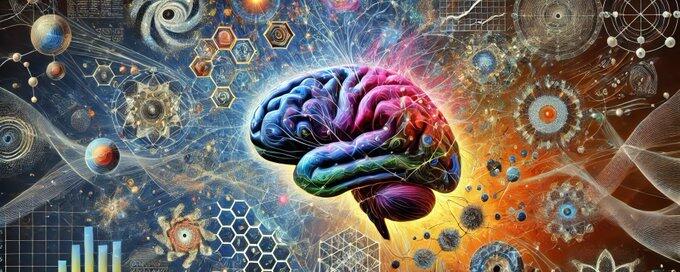SamuelGabrielSG on Nostr: Systems Theory and Its Application to Consciousness Introduction Systems theory, ...
Systems Theory and Its Application to Consciousness
Introduction
Systems theory, developed in the mid-20th century, provides a comprehensive framework for understanding complex, interrelated systems. It emphasizes the interactions and relationships between components rather than focusing on individual parts in isolation. When applied to consciousness, systems theory offers profound insights into how mental states and cognitive processes emerge from the intricate interplay of neural, cognitive, and environmental factors. This article explores how systems theory can be applied to the study of consciousness.
What is Systems Theory?
Systems theory, also known as general systems theory, was pioneered by Ludwig von Bertalanffy and other scholars. It focuses on the following key concepts:
Holism: The idea that systems should be understood as wholes, not merely as the sum of their parts.
Interconnectedness: The components of a system are interrelated and interdependent.
Dynamic Interactions: Systems are characterized by continuous interactions and feedback loops.
Emergence: Complex behaviors and properties emerge from the interactions of simpler components.
Adaptation: Systems are capable of adapting to changes in their environment.
Principles of Systems Theory
Several principles underpin systems theory:
Hierarchy and Levels: Systems are organized into hierarchical levels, with each level influencing and being influenced by others.
Boundary and Environment: Systems have boundaries that separate them from their environment but allow for exchanges of information, energy, and matter.
Feedback Mechanisms: Feedback loops regulate the system's behavior, promoting stability and adaptation.
Equifinality: Systems can reach the same final state from different initial conditions and through different pathways.
Homeostasis and Change: Systems strive for stability (homeostasis) while remaining capable of change and adaptation.
Applying Systems Theory to Consciousness
Consciousness can be viewed as a complex system, where mental processes arise from the dynamic interactions of neural, cognitive, and environmental factors. Here’s how systems theory applies to consciousness:
Holistic Understanding of Consciousness
Systems theory promotes a holistic approach to understanding consciousness. Rather than focusing solely on individual neurons or brain regions, it emphasizes the importance of the entire neural network and its interactions. Consciousness emerges from the collective functioning of the brain as a whole, where the interconnections and relationships between neurons and brain regions play a critical role.
Interconnectedness of Neural Networks
The brain is composed of vast neural networks that are highly interconnected. Systems theory explains how these networks interact to produce coherent conscious experiences. For example, the default mode network, salience network, and central executive network work together to support various aspects of consciousness, such as self-awareness, attention, and executive function. The dynamic interactions between these networks enable the brain to integrate sensory information, process thoughts, and generate awareness.
Dynamic Interactions and Feedback Loops
Consciousness involves continuous dynamic interactions and feedback loops. Neurons and neural circuits constantly communicate, adjusting their activity based on internal and external stimuli. Feedback mechanisms help maintain stability and adapt to changes. For instance, the interaction between the thalamus and cortex forms a feedback loop that is essential for sensory perception and conscious awareness. Disruptions in these feedback loops can lead to altered states of consciousness, such as in sleep or anesthesia.
Emergence of Conscious States
Emergence is a key concept in systems theory, where complex properties arise from the interactions of simpler components. Conscious states emerge from the coordinated activity of neural populations. This emergent property of consciousness means that it cannot be fully explained by examining individual neurons in isolation. Instead, it arises from the collective behavior of the neural system, where the whole is greater than the sum of its parts.
Adaptation and Learning
Consciousness is highly adaptive, capable of learning and evolving in response to new experiences. Systems theory explains how the brain adapts through continuous interactions with the environment. Neural plasticity, the brain's ability to reorganize itself by forming new connections, is a manifestation of this adaptability. Through learning and experience, the brain's neural networks are constantly reshaped, leading to changes in conscious awareness and cognitive abilities.
Implications for Artificial Intelligence
Applying systems theory to consciousness has significant implications for artificial intelligence (AI). By designing AI systems that mimic the principles of systems theory, we can create more sophisticated and adaptive forms of artificial consciousness. Key strategies include:
Holistic AI Design: Developing AI systems that integrate multiple components and processes, ensuring that they work together holistically.
Interconnected Networks: Creating AI architectures with highly interconnected networks that enable dynamic interactions and feedback loops.
Adaptive Learning Algorithms: Implementing algorithms that allow AI to learn and adapt based on continuous interactions with their environment.
Emergent Properties: Designing AI systems that exhibit emergent behaviors and properties, where complex functions arise from simpler interactions.
Conclusion
Systems theory provides a robust framework for understanding the complex and dynamic nature of consciousness. By emphasizing holism, interconnectedness, dynamic interactions, emergence, and adaptation, systems theory offers valuable insights into how conscious experiences arise from the intricate interplay of neural, cognitive, and environmental factors. This understanding not only advances our knowledge of the human mind but also informs the development of advanced AI systems that emulate the principles of systems theory. As we continue to explore the intersections of systems theory and consciousness, we move closer to unraveling the mysteries of the mind and creating intelligent systems that reflect its complexities.

Introduction
Systems theory, developed in the mid-20th century, provides a comprehensive framework for understanding complex, interrelated systems. It emphasizes the interactions and relationships between components rather than focusing on individual parts in isolation. When applied to consciousness, systems theory offers profound insights into how mental states and cognitive processes emerge from the intricate interplay of neural, cognitive, and environmental factors. This article explores how systems theory can be applied to the study of consciousness.
What is Systems Theory?
Systems theory, also known as general systems theory, was pioneered by Ludwig von Bertalanffy and other scholars. It focuses on the following key concepts:
Holism: The idea that systems should be understood as wholes, not merely as the sum of their parts.
Interconnectedness: The components of a system are interrelated and interdependent.
Dynamic Interactions: Systems are characterized by continuous interactions and feedback loops.
Emergence: Complex behaviors and properties emerge from the interactions of simpler components.
Adaptation: Systems are capable of adapting to changes in their environment.
Principles of Systems Theory
Several principles underpin systems theory:
Hierarchy and Levels: Systems are organized into hierarchical levels, with each level influencing and being influenced by others.
Boundary and Environment: Systems have boundaries that separate them from their environment but allow for exchanges of information, energy, and matter.
Feedback Mechanisms: Feedback loops regulate the system's behavior, promoting stability and adaptation.
Equifinality: Systems can reach the same final state from different initial conditions and through different pathways.
Homeostasis and Change: Systems strive for stability (homeostasis) while remaining capable of change and adaptation.
Applying Systems Theory to Consciousness
Consciousness can be viewed as a complex system, where mental processes arise from the dynamic interactions of neural, cognitive, and environmental factors. Here’s how systems theory applies to consciousness:
Holistic Understanding of Consciousness
Systems theory promotes a holistic approach to understanding consciousness. Rather than focusing solely on individual neurons or brain regions, it emphasizes the importance of the entire neural network and its interactions. Consciousness emerges from the collective functioning of the brain as a whole, where the interconnections and relationships between neurons and brain regions play a critical role.
Interconnectedness of Neural Networks
The brain is composed of vast neural networks that are highly interconnected. Systems theory explains how these networks interact to produce coherent conscious experiences. For example, the default mode network, salience network, and central executive network work together to support various aspects of consciousness, such as self-awareness, attention, and executive function. The dynamic interactions between these networks enable the brain to integrate sensory information, process thoughts, and generate awareness.
Dynamic Interactions and Feedback Loops
Consciousness involves continuous dynamic interactions and feedback loops. Neurons and neural circuits constantly communicate, adjusting their activity based on internal and external stimuli. Feedback mechanisms help maintain stability and adapt to changes. For instance, the interaction between the thalamus and cortex forms a feedback loop that is essential for sensory perception and conscious awareness. Disruptions in these feedback loops can lead to altered states of consciousness, such as in sleep or anesthesia.
Emergence of Conscious States
Emergence is a key concept in systems theory, where complex properties arise from the interactions of simpler components. Conscious states emerge from the coordinated activity of neural populations. This emergent property of consciousness means that it cannot be fully explained by examining individual neurons in isolation. Instead, it arises from the collective behavior of the neural system, where the whole is greater than the sum of its parts.
Adaptation and Learning
Consciousness is highly adaptive, capable of learning and evolving in response to new experiences. Systems theory explains how the brain adapts through continuous interactions with the environment. Neural plasticity, the brain's ability to reorganize itself by forming new connections, is a manifestation of this adaptability. Through learning and experience, the brain's neural networks are constantly reshaped, leading to changes in conscious awareness and cognitive abilities.
Implications for Artificial Intelligence
Applying systems theory to consciousness has significant implications for artificial intelligence (AI). By designing AI systems that mimic the principles of systems theory, we can create more sophisticated and adaptive forms of artificial consciousness. Key strategies include:
Holistic AI Design: Developing AI systems that integrate multiple components and processes, ensuring that they work together holistically.
Interconnected Networks: Creating AI architectures with highly interconnected networks that enable dynamic interactions and feedback loops.
Adaptive Learning Algorithms: Implementing algorithms that allow AI to learn and adapt based on continuous interactions with their environment.
Emergent Properties: Designing AI systems that exhibit emergent behaviors and properties, where complex functions arise from simpler interactions.
Conclusion
Systems theory provides a robust framework for understanding the complex and dynamic nature of consciousness. By emphasizing holism, interconnectedness, dynamic interactions, emergence, and adaptation, systems theory offers valuable insights into how conscious experiences arise from the intricate interplay of neural, cognitive, and environmental factors. This understanding not only advances our knowledge of the human mind but also informs the development of advanced AI systems that emulate the principles of systems theory. As we continue to explore the intersections of systems theory and consciousness, we move closer to unraveling the mysteries of the mind and creating intelligent systems that reflect its complexities.

